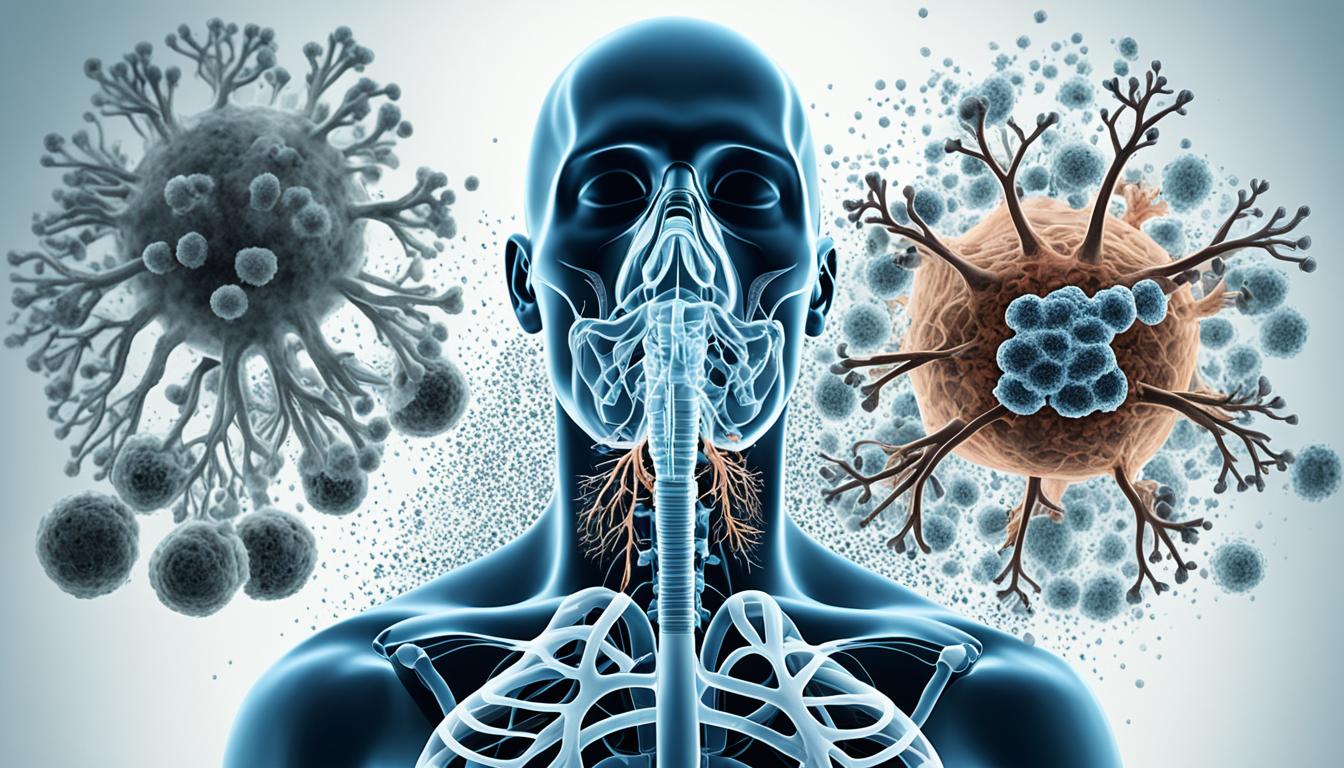
Health Effects of Black Mold: Risks & Symptoms
Welcome to our informational guide on the health effects of black mold. Black mold, also known as Stachybotrys chartarum, is a type of toxic mold that can have severe consequences on human health. Exposure to black mold can lead to a variety of risks and symptoms that should not be taken lightly.
Black mold releases spores into the air, which can be inhaled or come into contact with the skin. These spores contain mycotoxins that can trigger allergic reactions and cause respiratory problems. Prolonged exposure to black mold can lead to more serious health issues, especially in individuals with weakened immune systems.
Some of the risks associated with black mold exposure include:
- Respiratory issues
- Allergic reactions
- Asthma attacks
- Chronic sinus infections
- Compromised immune system
It’s crucial to be aware of the symptoms that may indicate black mold exposure. These symptoms can vary from person to person and may include:
- Coughing and sneezing
- Shortness of breath
- Nasal congestion
- Watery and itchy eyes
- Headaches
If you suspect black mold in your surroundings or experience any of these symptoms, it’s essential to seek professional help for a proper assessment and remediation. Ignoring the signs can lead to further health complications.
Remember, prevention is key. Proper moisture control and regular inspections can help reduce the risk of black mold growth in your home or workplace. By taking proactive measures, you can protect yourself and your loved ones from the potential health hazards associated with black mold.
Key Takeaways:
- Black mold exposure can have detrimental health effects.
- Risks may include respiratory issues, allergic reactions, and compromised immune systems.
- Common symptoms of black mold exposure include coughing, sneezing, and headaches.
- Seek professional help if you suspect black mold or experience related symptoms.
- Preventive measures such as moisture control can help reduce the risk of black mold growth.
Risks Associated with Black Mold Exposure
Black mold, also known as Stachybotrys chartarum, can pose significant risks to human health when exposed to it. The potential hazards extend beyond respiratory irritation and allergies commonly associated with mold exposure. In this section, we will delve deeper into the specific risks that come with exposure to black mold and explore how it can impact different systems of the body. Understanding these risks is crucial for taking appropriate measures to mitigate and prevent black mold in homes and buildings.
1. Respiratory System
- Respiratory Irritation: Breathing in black mold spores can cause irritation and inflammation in the respiratory tract, leading to coughing, sneezing, wheezing, and shortness of breath.
- Asthma Exacerbation: Individuals with pre-existing asthma may experience worsened symptoms when exposed to black mold, including increased frequency and severity of asthma attacks.
- Hypersensitivity Pneumonitis: Prolonged exposure to black mold can trigger a condition known as hypersensitivity pneumonitis, characterized by flu-like symptoms, coughing, shortness of breath, and lung inflammation.
2. Immune System
The immune system plays a crucial role in protecting the body against harmful substances. However, black mold can weaken the immune system, making individuals more susceptible to infections and other diseases. Mold exposure has been linked to increased risk of respiratory tract infections, sinusitis, and opportunistic fungal infections in individuals with compromised immune systems.
3. Nervous System
- Neurological Symptoms: Prolonged exposure to black mold may lead to neurological symptoms such as headaches, dizziness, memory loss, difficulty concentrating, and mood swings.
- Neurotoxicity: Certain mycotoxins produced by black mold have neurotoxic properties, which means they can damage nerve cells and affect cognitive function. Long-term exposure to these toxins may contribute to neurodegenerative diseases.
4. Other Potential Risks
In addition to the risks mentioned above, black mold exposure has been associated with other potential health concerns:
“Exposure to black mold can impact multiple systems in the body, increasing the risk of respiratory, immune, and neurological complications. It is crucial to address mold issues promptly to minimize the potential long-term consequences.”
| Risk | Description |
|---|---|
| Allergic Reactions | Black mold can trigger allergic reactions in susceptible individuals, causing symptoms such as skin rashes, itching, and eye irritation. |
| Toxicity | Some species of black mold produce mycotoxins that can have toxic effects when ingested, inhaled, or come into contact with the skin. |
| Respiratory Infections | Prolonged exposure to black mold may increase the risk of respiratory infections, particularly in individuals with weakened immune systems or chronic lung conditions. |
It is important to note that the severity of black mold-related health effects can vary depending on factors such as the individual’s sensitivity, duration and intensity of exposure, and overall health condition. If you suspect black mold in your environment or are experiencing unexplained health symptoms, it is advisable to seek professional assistance to assess and remediate the situation.
Symptoms of Black Mold Exposure
Exposure to black mold can have detrimental effects on both physical and respiratory health. It is important to be aware of the symptoms that may indicate mold exposure in order to take appropriate action. The following are common symptoms associated with black mold exposure:
Physical Symptoms
- Headaches
- Fatigue and weakness
- Joint and muscle pain
- Unexplained weight loss
- Gastrointestinal issues, such as nausea and diarrhea
These physical symptoms can range from mild to severe and may persist or worsen over time if the mold exposure continues.
Respiratory Symptoms
- Coughing
- Sneezing
- Wheezing
- Shortness of breath
- Runny or stuffy nose
Black mold spores can irritate the respiratory system, leading to these common symptoms. Individuals with pre-existing respiratory conditions, such as asthma, may experience more severe respiratory symptoms when exposed to black mold.
“Many people may mistakenly attribute these symptoms to other causes, such as seasonal allergies or a common cold. However, if you suspect black mold exposure, it is crucial to consider the possibility and take appropriate steps to address the issue.”
If you or your family members experience any of these symptoms and suspect black mold exposure, it is important to consult a healthcare professional for a proper diagnosis. Additionally, addressing the underlying mold issue is essential to prevent further health complications.

Conclusion
In conclusion, it is crucial to understand the health effects associated with black mold exposure. The risks involved can have serious consequences on our well-being. The symptoms of black mold exposure may manifest in various physical and respiratory ailments, signaling the need for immediate action.
Addressing mold issues in our homes or buildings should be a top priority. Prevention is key, and taking necessary measures like maintaining proper ventilation and controlling moisture levels can help minimize the risk of black mold growth.
Furthermore, if black mold is suspected or identified, it is essential to seek professional help for its removal. Ignoring the problem could lead to long-term health complications, especially for vulnerable individuals such as those with pre-existing respiratory conditions or weakened immune systems.




